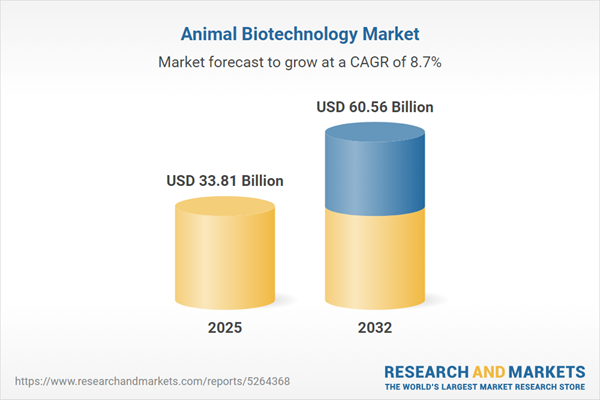Speak directly to the analyst to clarify any post sales queries you may have.
Animal biotechnology is rapidly transforming veterinary health and livestock management through advances in genetic engineering and molecular science. Senior decision-makers across agriculture and animal health industries require actionable intelligence to adapt to the sector’s ongoing evolution and competitive pressures.
Market Snapshot: Animal Biotechnology Market Growth and Outlook
The Animal Biotechnology Market grew from USD 31.04 billion in 2024 to USD 33.81 billion in 2025. With an expected CAGR of 8.71%, the market is projected to reach USD 60.56 billion by 2032.
This trajectory is driven by innovative approaches in gene editing, cell culture, and diagnostic solutions, pushing the boundaries of disease management, productivity, and animal welfare across global supply chains.Scope & Segmentation of the Animal Biotechnology Market
This report delivers an in-depth analysis of the drivers shaping the animal biotechnology landscape, including regulatory, technological, and regional influences. The scope spans commercial, research, and production arenas, offering detailed segmentation and trend analysis.
- Product Types: Recombinant proteins (antibodies, enzymes such as lipases, phytases, proteases, and growth hormones); Vaccines (DNA, inactivated, live attenuated, subunit vaccines).
- Technology Platforms: Cell culture (avian, insect, mammalian); Genetic engineering (gene editing, gene synthesis, transgenic technology); PCR and DNA sequencing (next-generation sequencing, PCR kits, Sanger sequencing).
- Applications: Diagnostics (ELISA kits, lateral flow assays, PCR-based tests); Drug discovery (lead optimization, preclinical testing, target identification); Feed additives (carbohydrases, phytases, proteases).
- End-Users: Animal farms, contract research organizations, pharmaceutical companies, research laboratories.
- Geographic Coverage: Americas (United States, Canada, Mexico, Brazil, Argentina, Chile, Colombia, Peru); Europe, Middle East & Africa (including the United Kingdom, Germany, France, Russia, Italy, Spain, Netherlands, Sweden, Poland, Switzerland, United Arab Emirates, Saudi Arabia, Qatar, Turkey, Israel, South Africa, Nigeria, Egypt, Kenya); Asia-Pacific (China, India, Japan, Australia, South Korea, Indonesia, Thailand, Malaysia, Singapore, Taiwan).
- Companies Analyzed: Zoetis Inc., Merck & Co., Inc., Elanco Animal Health Incorporated, Boehringer Ingelheim International GmbH, Ceva Santé Animale S.A., Dechra Pharmaceuticals PLC, Vetoquinol S.A., Phibro Animal Health Corporation, Virbac S.A., IDEXX Laboratories, Inc.
Key Takeaways for Senior Decision-Makers
- Gene editing tools, such as CRISPR, are enabling tailored interventions in livestock genetics, contributing to higher resilience and productivity.
- The convergence of digital technologies with animal biotechnology is supporting data-driven decision-making and remote animal health monitoring.
- Academic-industry partnerships are accelerating product development, derisking innovation, and facilitating adaptive business models.
- Growth in cell culture-based manufacturing platforms and recombinant technology is expanding vaccine and feed additive portfolios to meet precision requirements.
- Diverse regulatory regimes and harmonized frameworks across North America, Europe, and Asia-Pacific are shaping market access and compliance strategies, compelling global companies to adapt swiftly.
Tariff Impact on Global Trade and Supply Chains
Elevated United States tariffs introduced in 2025 have redefined global trade flows for animal biotechnology products and components. Manufacturers now prioritize supply chain resilience, re-evaluating sourcing and logistics to minimize tariff exposure. Cross-border research and innovation agreements are also adapting to manage shifting cost structures, with greater focus on regionalized production and contractual flexibility. These changes are driving transformation in procurement and partnership strategies throughout the sector.
Methodology & Data Sources
This report employs a robust hybrid research methodology, triangulating primary insights from industry experts and corporate strategists with secondary data from peer-reviewed literature, regulatory filings, and conference proceedings. Structured analysis frameworks, such as SWOT and value chain mapping, underpin the validation and reliability of findings.
Why This Report Matters for Strategic Planning
- Empowers leaders to anticipate regulatory changes and emerging risks in animal biotechnology.
- Offers competitive intelligence on technology trends, partnership models, and market entry opportunities by region and segment.
- Supports strategic investments in digital and bioprocessing infrastructure, enhancing resilience to supply chain and policy disruptions.
Conclusion
Animal biotechnology stands at the intersection of scientific advancement, regulatory evolution, and market expansion. Senior decision-makers gain a roadmap to leverage emerging trends and position their organizations for sustainable growth and innovation.
Additional Product Information:
- Purchase of this report includes 1 year online access with quarterly updates.
- This report can be updated on request. Please contact our Customer Experience team using the Ask a Question widget on our website.
Table of Contents
3. Executive Summary
4. Market Overview
7. Cumulative Impact of Artificial Intelligence 2025
Companies Mentioned
The companies profiled in this Animal Biotechnology market report include:- Zoetis Inc.
- Merck & Co., Inc.
- Elanco Animal Health Incorporated
- Boehringer Ingelheim International GmbH
- Ceva Santé Animale S.A.
- Dechra Pharmaceuticals PLC
- Vetoquinol S.A.
- Phibro Animal Health Corporation
- Virbac S.A.
- IDEXX Laboratories, Inc.
Table Information
| Report Attribute | Details |
|---|---|
| No. of Pages | 187 |
| Published | October 2025 |
| Forecast Period | 2025 - 2032 |
| Estimated Market Value ( USD | $ 33.81 Billion |
| Forecasted Market Value ( USD | $ 60.56 Billion |
| Compound Annual Growth Rate | 8.7% |
| Regions Covered | Global |
| No. of Companies Mentioned | 11 |









